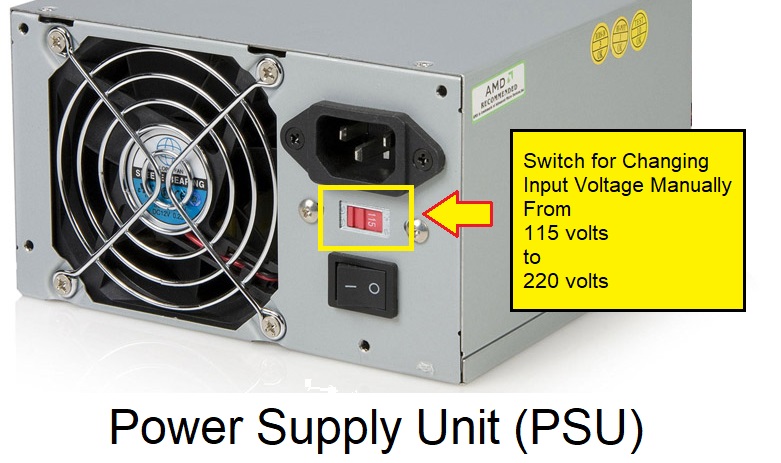AVR is the abbreviation of Automatic Voltage Regulator, while PSU stands for Power Supply Unit.
AVR is a device that provides a constant voltage to the devices connected to it, such as computers, display monitors, mobile phones, etc. On the other hand, a PSU is part of a computer system responsible for providing power to all the components of a computer system.
This article discusses, “Do you need an AVR if you have a PSU?” As both electronic devices provide constant power, knowing which is better for your computer system is necessary. We will answer the main question and then discuss its other aspects individually.
Do You Need AVR If You Have PSU?
You need an AVR (automatic voltage regulator) if you have a PSU (power supply unit) in your computer. The AVR is responsible for bearing multiple loads, voltage regulation, stabilization, short circuit protection, surge protection, etc. That is why it protects your PC PSU from fatal phenomena.
These phenomena include light striking, voltage fluctuation, flickering, short circuits, etc. They can burn out your computer hardware, such as CPU, GPU, memory modules, motherboard, SSD, etc. You must install an AVR to protect your computer system and its devices.
Most modern power supply units can act like an AVR (automatic voltage regulator) by operating on a range of 100 to 240 volts. They are also known as PFC (Power Factor Correction) PSUs. But they can only provide you with some of the benefits of Automatic Voltage Regulators.
What AVR does is automatic voltage regulation or stabilization. Simply put, it senses the input and changes its output accordingly. If the input is very high, it cuts off the circuit. When the input is high, it decreases the output; when it is low, it increases it.
Technically, these processes are also called bucking and boosting. As a result, the output is stabilized and constant. Cutting the output is an amazing feature of an AVR, known as surge protection. Surges are high spikes in the input power that can easily fry your computer components.
A Comparison Between AVR And PSU
| AVR (Automatic Voltage Regulator) | PSU (Power Supply Unit) |
| AVR regulates the output voltage to fulfill the exact power demand of an electronic device. | Power Supply has fixed output voltage for the computer hardware such as motherboard, SSDs, Graphics card, etc. |
| It is an external electronic device connected to a computer or other devices. | It is installed inside a computer case. |
| The AVRs have a surge protection mechanism. | PSUs do not have surge protection systems. |
| It has multiple outputs for connecting multiple devices, including computers. | It also has multiple outputs for multiple devices but is dedicated to computer hardware only. |
| The AVRs indirectly provide power to the peripheral devices. | The PSUs provide power directly to the peripheral devices of a computer system. |
| These can operate on 50 Hz and 60 Hz frequencies. | These can operate on one frequency at a time, either 50Hz or 60Hz. |
| The AVRs can operate on a range of voltages, such as from 119 volts to 240 volts AC. | The PSUs can operate on either 120 volts or 220 volts AC. Only PFC PSUs can operate from 100 volts to 240. |
| The output voltage of an AVR is AC (Alternating Current). | The output voltage of a PSU is always DC (Direct Current). |
| These control voltage fluctuation and flickering by providing constant power to a device. | These cannot control the voltage fluctuation and flickering as much. |
What Are The Benefits of Connecting an AVR to Your Computer System?
The AVRs are universal devices that can connect to nearly all the electronic devices in the world. It provides the devices their demanded power with multiple advantages over a simple power supply. Let’s discuss the pros of connecting an AVR to your computer system:
- Removal of Voltage Fluctuations and Flickering
You need an AVR even when you have a PSU because it will remove the voltage fluctuations and flickering from the electronic devices connected to your computer system. Voltage fluctuations occur when there are sudden rises and falls in the voltage levels. These can cause flickering in your devices.
The display monitor and LED lights are the electronic devices that often flicker on this. It can also burn out your devices connected to your computer system, such as motherboard, CPU, GPU, SSDs, keyboard, mouse, etc. That is why you need an AVR to eliminate voltage fluctuations and to flicker.
It protects your computer system and the peripheral devices connected to it by removing voltage fluctuations and flickering. As a result, the life of your devices increases dramatically. It saves you a lot of money you were about to spend buying a new device, which would burn out voltage fluctuations.
- Surge Protection
You need an AVR even when you have a PSU because it has a Surge protection mechanism. On the other hand, the PSUs have only a fuse or resistor to protect them from high power. Unlike this, the Automatic Voltage Regulator (AVR) protects itself and the devices connected to it.
A surge is a high-power spike that can burn out all devices simultaneously. Usually, these surges are produced when lightning strikes the main power wires. The AVRs have a mechanism for handling these power surges. They do this by disconnecting the power output within the nanoseconds or microseconds.
As a result, your computer system and other peripheral devices connected to it are safe from burning out. It also increases their lifetime, saving a reasonable amount of money. The AVRs also protect your devices from power surges in the main power due to malfunction from your power company.
- Automatic Voltage Regulation
You need an AVR even when you have a PSU because it is made for automatic voltage regulation. That is why it is known as AVR. The basic purpose of installing an AVR is to provide constant and demanded power to the output device. It does this by boosting and bucking the output voltage.
When the input power is low, the AVR increases it to a certain level, and when it is high, the AVR decreases it to a certain level. These processes are also known as boosting and bucking. As a result, the output voltage is constant according to the power demand of your computer system or other devices.
The components used in an AVR for automatic voltage regulation are solid state. It means they do not break even when the AVR accidentally hits a hard surface. The performance and efficiency of those components are also high. It also increases the performance and efficiency of your computer.
- Eliminate BSODs
You need AVR to eliminate BSODs (Blue Screens of Death) from your computer system even when you have a PSU. The power supply unit (PSI) is a PC only responsible for providing power to your computer system and its devices, such as the keyboard, mouse, motherboard, RAMs, CPU, etc.
When the input voltage from our main power drops, our computer shows us BSODs. These are blue screens with a sad face symbol that usually show the message about the problem in your computer system. They restart your computer, which is very annoying when it happens frequently.
An AVR (automatic voltage regulator) eliminates voltage drops by boosting the output voltage when the main supply power decreases. As a result, the output voltage remains constant for your computer system and the peripheral devices connected to it. It also protects your hardware.
- High Frequency and I/O Voltage Ranges
You need an AVR (Automatic Voltage Regulator) because it has high frequency and Input-Output voltage ranges compared to a computer PSU (power supply unit). The PSU can work on either 50 Hz or 60 Hz simultaneously. These configurations are manual, not automatic.
A PSU burns out if it is set for 50 Hz and you give it 60 Hz power. Unlike the PSU, the AVR can automatically switch between 50 Hz and 60 Hz only by sensing their input frequency. Similarly, the PSUs can either work on 115 volts or 220 volts at a time. These settings are also manual.
PSUs set on 115 volts burn out when you provide them with 220 volts. Unlike them, the AVRs can work from 119 to 240 volts without manual settings. They sense their input voltage and charge their output accordingly. This feature makes the AVRs a device that can be used universally.
- Powering Multiple Devices
You need an AVR even when you have a PSU because an AVR can connect multiple devices. These devices include your computer, display monitors, laptop, microphone amplifier, etc. On the other hand, the PSU can only power your PC’s motherboard, CPU, graphics card, SSDs, Fans, RAMs, DVD drive, etc.
The AVRs are available in different powers in the market. Their power ratings define the number of devices connected to them simultaneously. But, if you have an AVR whose power is 500 watts, you can connect multiple devices to it, which demand about 500 watts collectively.
But connecting a load of 525 watts to an AVR of 500 will burn it out immediately. You can easily calculate the total power of your computer system before buying the best-fit AVR for it. For this, write down all your devices’ names with their power rating and sum their powers up.
Conclusion
You need an AVR (Automatic Voltage Regulator) if you have a PSU because the purpose of installing both devices is different. The PSU is dedicated to powering your computer hardware such as motherboard, CPU, RAMs, GPU, keyboard, mouse, etc. In contrast, the AVR provides power to your PC and monitors.
The AVR has a high frequency and voltage range. It can operate from 50 Hz to 60 Hz frequency. Similarly, its operating voltage range is from 119 volts to 240 volts. Additionally, the output of an AVR is AC (alternating current), while the output of a PSU is pure DC (direct current).
The latest AVRs have an outstanding surge protection feature, which cuts off the power in case of a power surge such as lightning strikes. The AVRs also remove voltage fluctuations and flickering from your precious and expensive electronic devices. They also eliminate BSODs caused by low power.
The AVRs are available in different power ratings, such as 500 watts. Hence, they can power up devices such as PCs, multiple display monitors, mic amplifiers, etc. You can connect more devices if you have an AVR with a higher power rating and your devices are energy efficient.
The PFC power supply units have the potential to operate on very low and high voltage ranges. They can work on at least 100 volts and at most 240 volts. It is the only common feature between an AVR and a PSU. However, a PSU does not have abilities other than an AVR, so it is insufficient.

Hey, I’m Hammad. I write for this website to help you with the IT advice about PC, RAM, CPU, Motherboard, PSU, and other PC components.
I will provide detailed guides with images, and explain step by step so you can understand the process. Check all my articles here.









